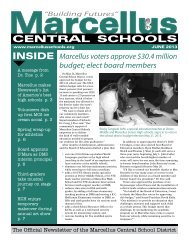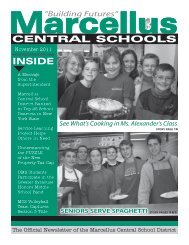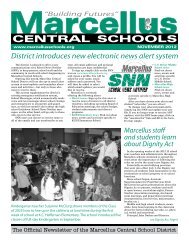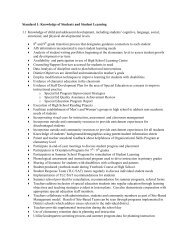Download the MCS Advocacy Toolkit (PDF) - Marcellus Central ...
Download the MCS Advocacy Toolkit (PDF) - Marcellus Central ...
Download the MCS Advocacy Toolkit (PDF) - Marcellus Central ...
- No tags were found...
Create successful ePaper yourself
Turn your PDF publications into a flip-book with our unique Google optimized e-Paper software.
“Building Futures”<strong>Central</strong> School District2Your voice can make a difference…Be an advocate for students in <strong>the</strong><strong>Marcellus</strong> <strong>Central</strong> School District<strong>Marcellus</strong> <strong>Central</strong> School District—like school districts throughout New York—is facing a fiscal crisis. The downturn of <strong>the</strong> national economy, coupled withnew mandates and <strong>the</strong> state’s tax levy limit, has challenged public schools tocontinue to provide a high-quality education to all students with significantlyfewer resources. As a result, districts are making devastating cuts toeducational programs as <strong>the</strong>y adjust to rising costs that are outpacing revenue.District leaders at <strong>Marcellus</strong> have been working with staff and communitymembers to find creative ways to wea<strong>the</strong>r <strong>the</strong> economic storm withoutsacrificing <strong>the</strong> integrity of our program. Yet without meaningful and timelyrelief from our government leaders, <strong>MCS</strong>D residents may risk losing <strong>the</strong> highlevel of public education that <strong>the</strong>y have come to know and value throughout<strong>the</strong> years.The time for change is now. The voices of school leaders and lobbyists forstate-level education groups simply are not enough, as recent legislative sessionshave shown. Elected officials need to hear from you, <strong>the</strong>ir constituents. Theyneed to hear from <strong>the</strong> people that are most directly impacted by <strong>the</strong>ir decisions(or indecisions) year after year—<strong>the</strong> students, parents, employees, residents,community groups and business owners of <strong>Marcellus</strong>.But what can I do?<strong>Advocacy</strong> takes many forms. It could be a note to an elected official, acomment made during a public forum, a letter to a newspaper editor or formaltestimony at public hearings. It could be as simple as chatting with neighborsto clear up misunderstandings about education issues or sharing educationrelatedstories with a local civic organization during monthly meetings.Becoming an advocate for education is not as hard as you might think.Anyone can become involved, at any level <strong>the</strong>y choose. The only prerequisitenecessary is a desire to fight for our students and our community schools.Effective advocates do <strong>the</strong>ir homework. They know <strong>the</strong> issues and plan<strong>the</strong>ir communication. Most of all, <strong>the</strong>y give <strong>the</strong>ir time to advance <strong>the</strong>ircause. Enclosed in this packet you will find several tools to help you becomean advocate for education and for <strong>MCS</strong>D. Thank you for taking <strong>the</strong> time toadvocate on behalf of <strong>the</strong> children of <strong>Marcellus</strong> and for helping to ensure that<strong>the</strong>y receive <strong>the</strong> high-quality education <strong>the</strong>y deserve.ADVOCACY CHECKLISTConcerned citizens at communityforums and public meetings oftenwonder what <strong>the</strong>y can do to help<strong>Marcellus</strong> students. The answer:Complete one or more of <strong>the</strong> items on<strong>the</strong> <strong>Advocacy</strong> Checklist below. Thenencourage your friends and neighborsto do <strong>the</strong> same!Empower yourself• Choose an issue affecting<strong>Marcellus</strong> <strong>Central</strong> Schools andlearn about that issue. Attenda school board meeting, readlocal and statewide educationpublications, or review <strong>the</strong> “factsheets” posted to <strong>the</strong> SchoolBudget News section of <strong>the</strong> districtwebsite (www.marcellusschools.org) to get started.• Develop and hone a “lasertalk”—a short, focusedmessage—about <strong>the</strong> issue youchose. A “laser talk” should brieflyidentify a problem, present asolution, and issue a call to action.It is a very useful tool when youhave only a minute or two ofsomeone’s attention and you wantto get a point across.Advocate with your electedrepresentatives• Send a letter or e-mail to locallegislators.• Call local legislators and scheduleface-to-face meetings.• Establish a relationship with <strong>the</strong>aides in legislators’ local offices.• Attend and ask questions at townhall meetings hosted by locallegislators.– continuedwww.marcellusschools.org
“Building Futures”<strong>Central</strong> School District3• Invite a local legislator to be yourguest at an <strong>MCS</strong>D special event.• Ask local legislators to agree totake a leadership role on yourselected issue.Advocate through <strong>the</strong> media• Write a letter to a newspapereditor and send your publishedletter to local legislators.• Copy editorials or newspaperarticles about your selected issueand send <strong>the</strong>m to local legislators.Advocate in <strong>the</strong> community• Host a discussion about yourselected issue at a local businessin your community.• Organize a letter-writing campaign.• Team up with a school leader tospeak to a local community group.• Participate in a community forumabout your selected issue.• Use social media to spread<strong>the</strong> word about what you areadvocating for:• Update your Facebook orTwitter status with a key pointfrom your “laser talk.”• Share links to relevant newsarticles or information from<strong>the</strong> school district website,www.marcellusschools.org.• Invite people to participatein events in your communityor online (virtual meetings)that are organized by you,<strong>the</strong> school district or ano<strong>the</strong>radvocate.• Follow legislators’ social mediaaccounts and feel free toreach out to <strong>the</strong>m using <strong>the</strong>secommunication tools.Key New York State legislators to contact foreducation/<strong>Marcellus</strong> CSD issues (as of 1/7/13)• Senator John A. DeFrancisco50th Senate District416 CapitolAlbany, NY 12247(518) 455-3511jdefranc@nysenate.gov: www.facebook.com/pages/Senator-John-A-DeFrancisco/8776617150: @JohnDeFrancisco• Chair of <strong>the</strong> NYS SenateEducation Committee: SenatorJohn J. FlanaganLegislative Office BuildingRoom 805Albany, NY 12247(518) 455-2071flanagan@senate.state.ny.us• NYS Senate Majority LeaderSenator Dean G. SkelosLegislative Office BuildingRoom 909Albany, NY 12247(518) 455-3171skelos@nysenate.gov: www.facebook.com/senatordeanskelos: @SenatorSkelos• Assemblyman Gary D. FinchLegislative Office BuildingRoom 448Albany, NY 12248518-455-5878finchG@assembly.state.ny.us• Chair of <strong>the</strong> NYS AssemblyEducation Committee:Assemblywoman Ca<strong>the</strong>rineNolanLegislative Office BuildingRoom 836Albany, NY 12248(518) 455-4851nolanc@assembly.state.ny.us• NYS Assembly SpeakerAssemblyman Sheldon SilverLegislative Office Building,Room 932Albany, NY 12248(518) 455-3791speaker@assembly.state.ny.us• Governor Andrew M. CuomoNYS State Capitol BuildingAlbany, NY 12224(518) 474-8390Visit www.governor.ny.gov andclick “Contact”: www.facebook.com/GovernorAndrewCuomo: @NYGovCuomowww.marcellusschools.org
“Building Futures”<strong>Central</strong> School District4What does effective advocacy look like?Personal contact with legislators helps buildrelationships and establish lines of communicationthat ensure that <strong>the</strong> district’s story is being heard.Whe<strong>the</strong>r you choose to contact your representativesby phone, e-mail or in-person, please keep in mind <strong>the</strong>following tips to help you convey your message in <strong>the</strong>most effective way possible:• Be brief. Stick to your key points and be mindfulthat legislators are often very busy and face avariety of special interest groups that compete for<strong>the</strong>ir time and attention.• Be respectful. Even if you disagree on a position, berespectful in your dialogue and stick to <strong>the</strong> facts.When appropriate be passionate, not emotional.• Be clear and specific. Let legislators know exactlywhat you want <strong>the</strong>m to do (i.e., vote in favor of abill, pass legislation) in a way that requires a “yes”or “no” response. Ask <strong>the</strong>m how <strong>the</strong>y will vote,follow-up on your conversation, and hold <strong>the</strong>maccountable.• Be a reliable source of information. Research yourissue and know <strong>the</strong> facts so that you can provideinformation to legislators and answer <strong>the</strong>irquestions. Do not assume that legislators knowspecifics about <strong>the</strong> school district or education issuesin general. Be prepared to follow-up with answers toany questions you may not know on <strong>the</strong> spot.• Be honest about your concerns. Paint <strong>the</strong> real pictureof your situation, even if it is scary. Share <strong>the</strong>ramifications of an action/inaction for yourcommunity’s schools and children. Use personal orcompelling stories coupled with facts and data.• Be timely and persistent. If an issue has a deadline,such as <strong>the</strong> passage of <strong>the</strong> state budget, makesure you give legislators enough time to respondto <strong>the</strong> issue. Frequent, regular reminders about<strong>the</strong> importance of <strong>the</strong> issue, particularly frommultiple advocates, can increase <strong>the</strong> likelihood thatlegislators will pay attention to <strong>the</strong> cause.Tips for effective written correspondenceSome forms of written communication are more effective than o<strong>the</strong>rs. While e-mails and form letters are fine,personal letters (perhaps even hand-written) convey a stronger message. They demonstrate <strong>the</strong> importance of yourconcerns by showing you went out of your way to make <strong>the</strong>m known. Writing a letter and making a follow-up phonecall takes a few minutes, but those steps ensure that your legislator knows just how you want to be represented.When writing a letter, you should:• Keep your letter short; a single page is best.• Be concise and specific, but add personal toucheson how your selected issue impacts you and yourfamily.The letter should include <strong>the</strong> following parts:• Introduction• Problem statement• Proposed solution• Conclusion and call to actionBe sure to include all of your contact information (e.g., home address, phone number, e-mailaddress), so your legislator can reply to you.www.marcellusschools.org
“Building Futures”<strong>Central</strong> School District5Be sure to include all of your contact information (e.g., home address, phone number, e-mail address), soTips for effective in-person meetingsyour legislator can reply to you.A face-to-face meeting with your legislator is a great way to personalize an issue, and to make sure that your feedbackis heard. It is also a great opportunity to educate your representatives about a particular issue and to answer anyquestions <strong>the</strong>y may have on <strong>the</strong> topic. Community members can choose to meet with legislators on an individual basis,or go in as a small group (no more than two to three people).Before <strong>the</strong> meeting• Make an appointment• Prepare for <strong>the</strong> meeting• Define your goals• Ga<strong>the</strong>r <strong>the</strong> facts• Ga<strong>the</strong>r data• Practice your talking points• Reconfirm <strong>the</strong> meeting by phone a few daysbefore <strong>the</strong> meetingDuring <strong>the</strong> meeting• Be on time• Introduce yourself• Be polite and gracious• Stay on topic• Tell <strong>the</strong> legislator why you are <strong>the</strong>re• Give background on your issue• Tell your story and explain <strong>the</strong> impact ofany action/inaction• Make your recommendation or request foraction• Get a commitment• Allow time for questions• Respect <strong>the</strong> legislator’s schedule and end <strong>the</strong>meeting on time• Leave your contact information and anysupporting materialsAfter <strong>the</strong> meeting• Send a thank you note• Follow-up on action items• Sustain <strong>the</strong> relationshipGeneral “Do’s and Don’ts” for talking with legislatorsDoDon’t• Introduce yourself and identify which cause youare associated with• Thank <strong>the</strong>m for <strong>the</strong>ir service to <strong>the</strong> community and for <strong>the</strong>irtime to meet with you and/or read your letter• Remember that you are a constituent and have every right toexpress your opinions, ideas, and concerns• Stick to a few key points (“laser talk”) when communicatingwith legislators• Get back to legislators with answers to questions<strong>the</strong>y may have• Ask for some sort of action from <strong>the</strong> legislator, and follow-upto be sure that action was taken• Develop a relationship with <strong>the</strong> aides in your legislator’s office• Overwhelm legislators with excessive facts, figures, or jargon• Lecture your legislator• Be rude or intimidating• Get into a lengthy conversation that strays from <strong>the</strong> original topic• Overstay your allotted meeting time• Be afraid to admit when you do not know <strong>the</strong> answer to a question• Expect <strong>the</strong> legislators to be experts on <strong>the</strong> issues• Maintain your relationship with legislators throughout <strong>the</strong> year• Underestimate your influencewww.marcellusschools.org
f a c t s h e e tC e n t r a l S c h o o l D i s t r i c tNYS Gap Elimination AdjustmentWhat is it?The Gap Elimination Adjustment (GEA)law was first introduced for <strong>the</strong> 2010-11fiscal year by <strong>the</strong>n-Governor Paterson asa way to help close New York’s <strong>the</strong>n $10billion budget deficit. Under <strong>the</strong> legislation,a portion of <strong>the</strong> funding shortfall at <strong>the</strong>state level is divided among all schooldistricts throughout <strong>the</strong> state and reflectedas a reduction in school district state aid.The GEA is a negative number, money thatis deducted from <strong>the</strong> aid originally due to<strong>the</strong> district. In 2012-13, <strong>Marcellus</strong> <strong>Central</strong>School District saw an overall loss in fundsof $1.96 million as a result of <strong>the</strong> GEA.Since <strong>the</strong> program began three years ago,<strong>the</strong> total GEA reduction in school aid for<strong>MCS</strong>D amounts to $6.3 million. Prior toimplementation of reductions in aid through<strong>the</strong> GEA, state aid to <strong>Marcellus</strong> was reduced $1.66 million via a“Deficit Reduction Assessment,” bringing <strong>the</strong> cumulative loss inaid to $8 million in a four-year period.Why does it matter?While it may make sense to state leaders to pass along fundingshortfalls to <strong>the</strong> local level, <strong>the</strong> “trickle-down” effect of <strong>the</strong>sereductions ultimately falls onto <strong>the</strong> backs of school districtsand in turn, local taxpayers. When revenues decline and costscontinue to rise, government agencies, including schools, havethree options: increase taxes to pay for programs and servicesat existing levels, reduce or eliminate programs and services, orrethink <strong>the</strong> delivery of programs and services.<strong>MCS</strong>D has employed a combination of all three optionsthroughout <strong>the</strong> past few years—delivering programs and servicesin new and creative ways, reducing where necessary based onstudent-driven needs data, and increasing taxes accordingly. Yet<strong>the</strong>re is only so much that <strong>the</strong> district can do to be creative whenyear after year we are receiving less state aid than anticipated.There is only so much we can reduce or eliminate before <strong>the</strong>academic program begins to suffer. And <strong>the</strong>re is only so muchwe can ask of our taxpayers, who are also feeling <strong>the</strong> pinch of astagnant economy. As it now stands, Governor Cuomo and <strong>the</strong><strong>Marcellus</strong> has eliminated more than 45full-time equivalent positions since <strong>the</strong>GEA was first enacted in 2010, resultingin increased class sizes at all levels.We have responsibly adjusted staffinglevels in all areas to mitigate <strong>the</strong> lossof state aid, and believe our studentscontinue to receive <strong>the</strong> same educationalexperiences that were being deliveredprior to <strong>the</strong> financial downturn. Howeverwe are running out of options and areconcerned we will experience a loss ofextracurricular and elective programs in<strong>the</strong> near future. It is at that point thatstudents and community members willnotice something tangible missing from<strong>the</strong> <strong>Marcellus</strong> program. Summarily, itis essential that our community reactsbefore <strong>the</strong>se losses occur.www.marcellusschools.orgstate Legislature are continuing to apply a GEA for 2013-14school funding. Even more concerning is that according to <strong>the</strong>NYS Division of <strong>the</strong> Budget, <strong>the</strong> state’sprojected deficit is expected to grow in 2014-15 and 2015-16—leading school districts towonder whe<strong>the</strong>r <strong>the</strong>re is an end in sight to<strong>the</strong> devastating GEA reductions that havebecome part of state law.What can I do about it?As revenues decline or are o<strong>the</strong>rwiselimited (e.g., GEA reductions) and schoolcosts rise to unsustainable levels, reductionsin program and staffing become necessaryto balance <strong>the</strong> equation. Local communitymembers must speak up on behalf of <strong>the</strong>irstudents now or risk losing <strong>the</strong> “<strong>Marcellus</strong>education” <strong>the</strong>y have come to expect.Without relief, class sizes will continue toincrease and opportunities for students willcontinue to decrease. <strong>Marcellus</strong>—along withcountless schools throughout <strong>the</strong> state—maysoon be forced to offer only <strong>the</strong> minimum mandated level ofpublic education in New York if funding continues to be withheld.Below are three easy ways you can help:• Learn about New York’s Gap Elimination Adjustment and how itimpacts your school district—fiscally and in relation to programs/services.• Write letters to your legislators asking <strong>the</strong>m to support <strong>the</strong>elimination of GEA reductions.• Meet face-to-face with your legislators to explain <strong>the</strong> impactof GEA reductions on your students, your schools, and yourcommunity.WHAT Was THE LOSS IN STATE AID PERSTUDENT DUE TO THE GEA IN 2012-13?In 2012-13, <strong>MCS</strong>D saw an overall loss in funds of $1.96million as a result of <strong>the</strong> GEA. That equates to a loss instate aid of approximately $1,059 per student.










